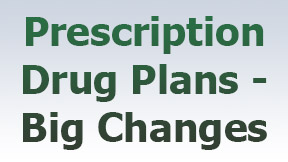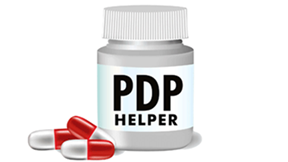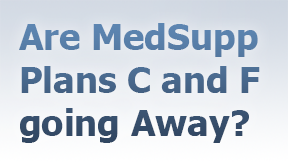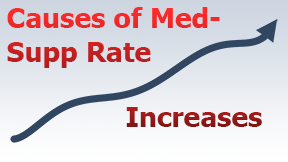by Lance D. Reedy
Unfortunately, many people still mistakenly believe that they can’t change their Medicare supplement plan after the December 7th AEP deadline. As such, we have updated this article for 2020.
The good news is that you can change your Medsupp plan any month of the year, providing that you medically qualify. If your Medsupp rate increases have been above normal, you may be able to qualify for a lower premium plan.
Yes, you can change your Medicare supplement plan any month of the year as long as you medically quality with the new company.
We work with most of the Medicare supplement companies and can assist you in shopping for lower rates. Please call us first!
Remember, medical qualification applies. More about this shortly.
Another smart move, if possible, is to change your plan letter. For example, if you have an increasingly spendy Plan F with Company X, a good solution is to switch to Plan G. Another good reason to move out of Plan F is that people turning 65 after January 1, 2020 are not able to sign up for Plan F. Note: This does not need to be done right away, but it’s something to think about for the future. As these existing Plan F’s age, they will continue to go up.
How do I qualify for a new Medicare Supplement plan?
To qualify for a new Medsupp plan, in general you will need “No” answers to the following health questions. The language on each companies’ application may vary somewhat, but they are similar.
1) In the last two years have you had or been treated for circulatory or heart disease including a heart attack, heart bypass surgery, stent placement, atrial-fib, or pacemaker implantation?
2) Have you been treated for internal cancer, melanoma, or lymphoma in the last two years? (Does not include most skin cancers.)
3) Have you had a stroke or TIAs in the past two years?
4) Have you been diagnosed or treated for COPD, emphysema, or chronic bronchitis in the past two years?
5) Have you been hospitalized more than two times in the last two years?
6) Have you been diagnosed with any type of dementia, Alzheimer’s, or Parkinson’s disease? Note: One of our companies will take people with these conditions if there are no other major issues.
7) Do you have any auto-immune disease such as AIDs, HIV, multiple sclerosis, rheumatoid arthritis etc? (Other diseases may be included depending on the company.)
8) Do you have any planned procedures like physical therapy or surgeries such as a joint replacement or a cataract surgery recommended to be completed in the next twelve months?
These are the major categories. A company may request additional information.
Routine prescriptions such as blood pressure, cholesterol, and type 2 diabetes meds are usually okay. Most companies have a drug decline list. Examples are opioids and many cancer related drugs. The companies generally require that you list all prescriptions on your application. Certain combinations of drugs such as ones used to treat diabetes (particularly insulin) and hypertension may cause a decline with one or two companies.
Why do we pre-qualify you before applying?
If you have a medical condition that is iffy, we can shop for the company that is most likely to accept your application. One company may be more picky about one particular health issue compared to another. Through the years, we have learned that a certain health issue that may not fly with one company can go through with another. Many companies will decline hydrocodone use, but one or two companies will consider your application.
Why are some people reluctant to change if they can quality for substantially lower rates?
The biggest reason that we have seen is fear. They are afraid that the new company won’t pay its claims. However, this fear is completely unfounded. The plans are standardized, and all companies pay their claims. We have encountered folks who could save $80 per month or more by changing out of an old, expensive plan. Unfortunately, a few of them wouldn’t budge because they were deathly afraid that their new company won’t pay its claims.
Do we ALWAYS shop for the lowest rate available?
Not necessarily. In fact, there are a couple of companies that we avoid. One of them was owned by one hedge fund that pawned it off to another hedge fund. The game they play is to come out with absurdly low rates. People will chase those rates only to discover that within two years or so the rates are going through the roof.
This game is called “buying the business.” A company is willing to break even or even lose money to get a bunch of people signed up. They also entice agents to peddle their product with high commissions and lucrative production bonuses. Within two years or so they go to the state insurance department, show their losses, and file for big rate increases. Meanwhile, If a person has developed an uninsurable condition, he/she is stuck with that company. Sorry, that’s not a game we’re going to play. We prefer to work with reputable companies.
What if I have a health issue that no new company will accept?
The solution for the people in this situation may be switching to a Medicare advantage (MA) plan during the fall October 15 through December 7th Annual Election Period (AEP), also known as Medicare open enrollment.
There are pros and cons involved in switching to an MA plan. Please contact us for details. On the other hand, many people are happy enough with their current plan. Nothing says that you have to change.
Why is it much easier to switch to a Medicare advantage (MA) plan?
The only health question on an MA application is kidney failure. You could have had a recent stroke, been treated for cancer in the past two years, or have multiple sclerosis, and you still can qualify for an MA plan. Those conditions will likely cause a decline on most any Medsupp company’s application.
However, switching to an MA plan is not feasible for some people if they live in a county that has no available MA plan.
How do I find out if I’m eligible for lower rates? Please call us at (208) 746-6283 or (888) 746-6285, or email us at lance@nwsimail.com. If you have a health situation that you believe may be an issue, contact us anyway, and we’ll see what we can do. End

 It seems like not a year goes by without some major shakeup regarding either Medicare advantage or Medicare Part D Prescription (PDP) plans. This year we have changes on steroids.
It seems like not a year goes by without some major shakeup regarding either Medicare advantage or Medicare Part D Prescription (PDP) plans. This year we have changes on steroids. This 2019 AEP is our fourth year of using
This 2019 AEP is our fourth year of using  221 million prescriptions…
221 million prescriptions… Note: I thank Ron Iverson, president of NAMSMAP* for assembling this data. This information comes from the National Association of Insurance Commissioners. *National Association of Medicare Supplement and Medicare Advantage Producers. This article is a revision from one published earlier this year.
Note: I thank Ron Iverson, president of NAMSMAP* for assembling this data. This information comes from the National Association of Insurance Commissioners. *National Association of Medicare Supplement and Medicare Advantage Producers. This article is a revision from one published earlier this year.

